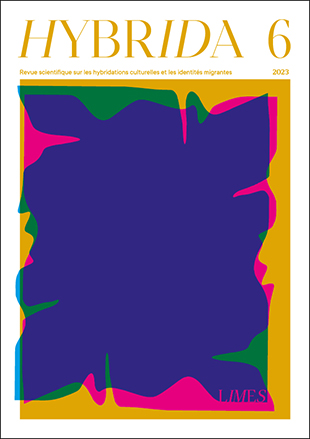El papel de la «frontera» en la conceptualización de la identidad imperial rusa: un estudio basado en prisioneros políticos polacos
DOI:
https://doi.org/10.7203/HYBRIDA.6.26243Palabras clave:
Siberia y Asia Central / Exiliados polacos / «Triángulo siberiano» polaco, imperialismo ruso / Postcolonialismo Resumen
Resumen
Este artículo explora los entresijos de la construcción y definición de la identidad de los individuos que residían en las fronteras meridional y oriental del Imperio ruso. Los habitantes de estas ciudades y fortificaciones imperiales, enclavadas entre dos culturas, consistían principalmente en individuos desplazados a la fuerza y su progenie, aparte de los que prestaban servicio militar o administrativo. La presencia de exiliados polacos en las periferias oriental y meridional del Imperio ruso fue consecuencia directa de su política expansionista. A través de los diarios, la correspondencia y las obras publicadas de tres presos políticos polacos –Adolf Januszkiewicz, Bronis?aw Zaleski y Seweryn Gross– nos adentramos en las complejas, ambiguas y polifacéticas identidades de sus opresores, los habitantes de la estepa y los propios exiliados políticos, todos entrelazados en complejas relaciones coloniales. Esta investigación pone en tela de juicio distinciones simplistas como «nosotros» frente a «ellos» y «aquí» frente a «allí».
 Descargas
Descargas
 Citas
Citas
Adamczewski, P. (2019). Polski mit etnopolityczny i Kaukaz. ISP PAN.
Anderson, B. (2006). Imagined communities. Reflections on the origin and spread of nationalism. Verso.
Baliński, T., & Rakoczy, M. (2015). Antropologia szkoły: tradycje, postulaty, inspiracje. Almanach Antropologiczny Communicare, 5, 7–25. https://doi.org/10.31338/uw.9788323518075
Bassin, M. (1991). Inventing Siberia: visions of the Russian East in the early nineteenth century, American Historical Review, 96(3), 763–794. https://doi.org/10.2307/2162430
Bekmakhanov, E. (1992). Kazakhstan v 20-40 XIX veke. Kazak Universiteti.
Bhabha, H. K. (1994). The locations of culture. Routledge.
Caban, W. (2001). Służba rekrutów z Królestwa Polskiego w armii carskiej w latach 1831–1873. DiG.
Caban, W. (2006). Z Orenburga do Paryża. Bronisław Zaleski 1820-1880. Wydawnictwo Akademii Świętokrzyskiej.
Connerton, P. (1989). How societies remember. Cambridge University Press.
Cywiński, B. (2013). Szańce kultur. Szkice z dziejów narodów Europy Wschodniej. Trio.
Driver, F., & Gilbert, D. (1999). Imperial cities: overlapping territories, intertwined histories. In F. Driver and D. Gilbert (Eds.), Imperial cities (pp. 1–17). Manchester University Press.
Fanon F. (2008). Black Skin, White Masks. (Translated by C. L. Markmann) Pluto Press.
Foucault, M. (1981). The order of the discourse. In R. Young (Ed.), Untying the text: a post-structuralist reader, (pp.48–78). Routledge & Kegan Paul.
Gawrycki, M.F., & Szeptycki, A. (2011). Podporządkowanie – niedorozwój – wyobcowanie. Postkolonializm a stosunki międzynarodowe. WUW.
Gerasimov, I., Glebov, S., Kaplunovski, A., Mogilner, M., & Semyonov, A. (2012). The centrality of periphery, Introduction. Ab Imperio, (1), 19-28. https://doi.org/10.1353/imp.2012.0026
Goody, J. (2001). The logic of writing and the organization of society. Cambridge University Press.
Gramsci, A. (1971). Selection from the prison notebooks. (Edited and translated by Q. Hoare and G. Nowell Smith). Lawrence & Wishart.
Hobsbawm, E. (1989). The age of Empire 1875-1914. Vintage Books.
Janion, M. (2006). Niesamowita słowiańszczyzna. Fantazmaty literatury, Wydawnictwo Literackie.
Januszkiewicz, A. (2003). Listy z Syberii. (Ed. H. Geber). Czytelnik.
Januszkiewicz, A. (2013). Listy ze stepów kirgiskich i dziennik podróży. (Ed. H. Geber). PTL.
Jedlicki, J. (2014). The Vicious Circle 1832–1864. A History of the Polish Intelligentsia – Part 2. (translated by T. Korecki) Peter Lang.
Kaczyńska, E. (1991). Syberia: największe więzienie świata 1805-1914. Oficyna.
K[alinka], W. (1881). Z Orenburga. Przegląd Polski.
Käkitai, Tutgul Kunanbai, (1909), Qazaq aqyny Ibrahim Qunanbai ulghynyn ölni, Санкт-Петербург.
Kennan, G. (1906). Sibir’ i ssilka, V. Vrublevskogo.
Kieniewicz, S. (1977). Wpływ zaboru rosyjskiego na świadomość społeczeństwa polskiego. Dzieje najnowsze, IX – 4, 105–115. https://rcin.org.pl/dlibra/doccontent?id=50365
Khodarkovsky, M. (2004). Russia’s steppe frontier. The making of a colonial empire 1500-1800. Indiana University Press.
Kristeva, J. (1982). Powers of horror: an essay on abjection. (Translated by L. Roudiez). Columbia University Press.
Le Goff, J. (2007). Historia i pamięć. (Translated by A. Gronowska and J. Stryjczyk). WUW.
Macińska, M. (2014). At the Crossroads: 1865–1918: A History of the Polish Intelligentsia – Part 3. (Translated by T. Korecki). Peter Lang.
Malinowski, B. (2001). Prawo, zwyczaj, zbrodnia w społeczności dzikich. De Agostini Altaya.
Materialy dlya izucheniya yuridicheskih obichaev kirgizov, vip.1, materialnie pravo. (1886). Omsk.
Milewska-Młynik, A. (2012). Seweryn Gross wśród badaczy kazachskiego prawa zwyczajowego, Muzeum Niepodległości.
Mitchell, T. (1991). Colonising Egypt. University of California Press.
Simpson, Y. (1999). ‘Capital of Colonies’: real and imagined boundaries between metropole and empire in 1920s Marseilles. In F., Driver & D. Gilbert, Imperial cities (pp. 136-154). Manchester University Press.
Osterhammel, J. (2014). The transformation of the world. A global history of the nineteenth century. (Translated by P. Camiller). Princeton University Press.
Pavlenko, S. (2015). Zesłanie jako spotkanie kolonialne. Przestrzeń Uralu i Syberii w oczach Tomasza Zana. Świat Tekstów. Rocznik Słupski, (13), 5–31. https://swiattekstow.apsl.edu.pl/images/publikacja/13/pavlenko.pdf
Polish Library in Paris, manuscripts 476. (s.d).
Pratt, M. L. (1992). Imperial eyes. Travel writing and transculturation. Routledge.
Remvev, A. (2000). Regionalnie parametru imperskoy ‘geografii vlasti’ (Sibir’ i Dalniy Vostok). ab-Imperio 3–4, 343-358. https://doi.org/10.1353/imp.2000.0045
Remnev, A. (2004). Rossia dalnego vostoka. Imperskaya geografiya vlasti XIX- nachala XX vekov. OmGU.
Remnev, A. (2009), ‘Tigr zakolotiy gusinim perom’. Kazus zapadnosibirskogo general-gubernatora knyazya P.D. Gorchakova. Acta Slavica Iaponica, (27), 55–75.
Remnev, A., & Sukhih O. (2006). Kazachskie deputacii v scenariyach vlasti: ot diplomaticheskikh missiy k imperskim pretenziyam. ab-Imperio, (1), 119–154. https://doi.org/10.1353/imp.2006.0023
Sapargalijew, G., & Djakow, W. (1982). Polacy w Kazachstanie w XIX w. (Translated by A. Trombala and J. Plater). Czytelnik.
Schick, I. C. (2012). Seksualność Orientu. Przestrzeń i eros. (Translated by A. Gąsior- Niemiec). Oficyna Naukowa.
Soja, E. (1996). Thirdspace: Journeys to Los Angeles and Other Real-and-Imagined Places. Oxford
Sowa, J. (2011). Fantomowe ciało króla. Peryferyjne zmagania z nowoczesną formą. Universitas.
Spivak, G. Ch. (1994). Can the Subaltern Speak? In P. Williams, L. Chrisman L., Colonial Discourse and Post-Colonial Theory. A reader, (pp. 66–111). Colombia Press.
Stoler, A. L. (2009). Making Empire Respectable: The Politics of Race and Sexual Morality in 20th-Century Colonial Cultures. American Ethnologist 16(4), 634–660. http://www.jstor.org/stable/645114
Sunderland, W. (2003). Empire without Imperialism? Ambiguities of Colonization in Tsarist Russia. ab-Imperio 2, 101-114. https://doi.org/10.1353/imp.2003.0036
The Princes Czartoryski Library, manuscripts 6928. (s.d.).
Thompson, E. M. (2000). Imperial knowledge: Russian literature and colonialism. Greenwood Press.
Uly Abaigha adaldyk (Estelikter, maqalalar, suretti shezhireler). (2002). Semey.
Vasil’ev, D. (2014). Rossiya i Kazachskaya step’: administrativnaya politika i status ukraini XVIII-pervaya polovina XIX veka. Politicheskaya enciklopediya.
Walikhanov, S. (1904), Sochineniya Shokana Walikhanova. Zapiski Imperatorskogo Geograficheskogo Obshestva po otdeleniyu etnografii XXIX, Sankt-Perergurg.
Wallerstein, I. (2006). European universalism. The rhetoric of power. The New Press.
Zaleski, B. (2008). Wspomnienia z Uralu i stepów kazachskich. (Ed. A. Zieliński). PTL.
Descargas
Publicado
Cómo citar
-
Resumen199
-
HTML 217
-
PDF 123
Número
Sección
Licencia
![]()
Todos los documentos en la plataforma OJS son de acceso abierto y propiedad de sus respectivxs autorxs.
Lxs autorxs que publican en la revista aceptan los siguientes términos:
- Lxs autorxs conservan los derechos y garantizan a HYBRIDA el derecho a ser la primera publicación del documento, con licencia de Creative Commons de Atribución-NoComercial-CompartirIgual 4.0 Internacional (CC BY-NC-SA 4.0) que permite a otros compartir el trabajo con un reconocimiento de autoría y publicación en la revista.
- Se permite y se anima a lxs autorxs a difundir su trabajo (una vez publicado) a través de medios electrónicos utilizando sitios web personales o institucionales (archivos abiertos institucionales, sitios web personales o perfiles de redes profesionales y académicas).
















